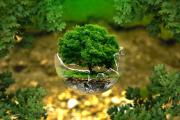The Need for Improved Landscape Efficiency
How much water does it take to grow an attractive and healthy landscape? It all depends on factors such as local climate, the type of plants in the landscape, soil conditions, shading, and maintenance practices. Certainly some healthy landscapes require no supplemental irrigation beyond what falls from the sky, yet others must rely on substantial amounts of applied water. In a perfect world, everyone would put exactly the right amount of water on their landscape to keep it healthy and attractive without any excess runoff or water waste. That ideal is what water utility landscape efficiency programs strive to achieve.
Research has shown that -- on average -- about half of the water used in a single-family American home during the course of a year will be put onto the landscape. In a wet climate such as the Pacific Northwest, less water is required for irrigating a turf landscape compared with a hot dry climate like Arizona. But even in a wet climate, the landscape area is often the single highest user of water. And in most cases, the water applied to the landscape has been treated to potable drinking water standards.
Members see more great content.
To learn more about membership or sign up to become a member, please visit our Members section.





